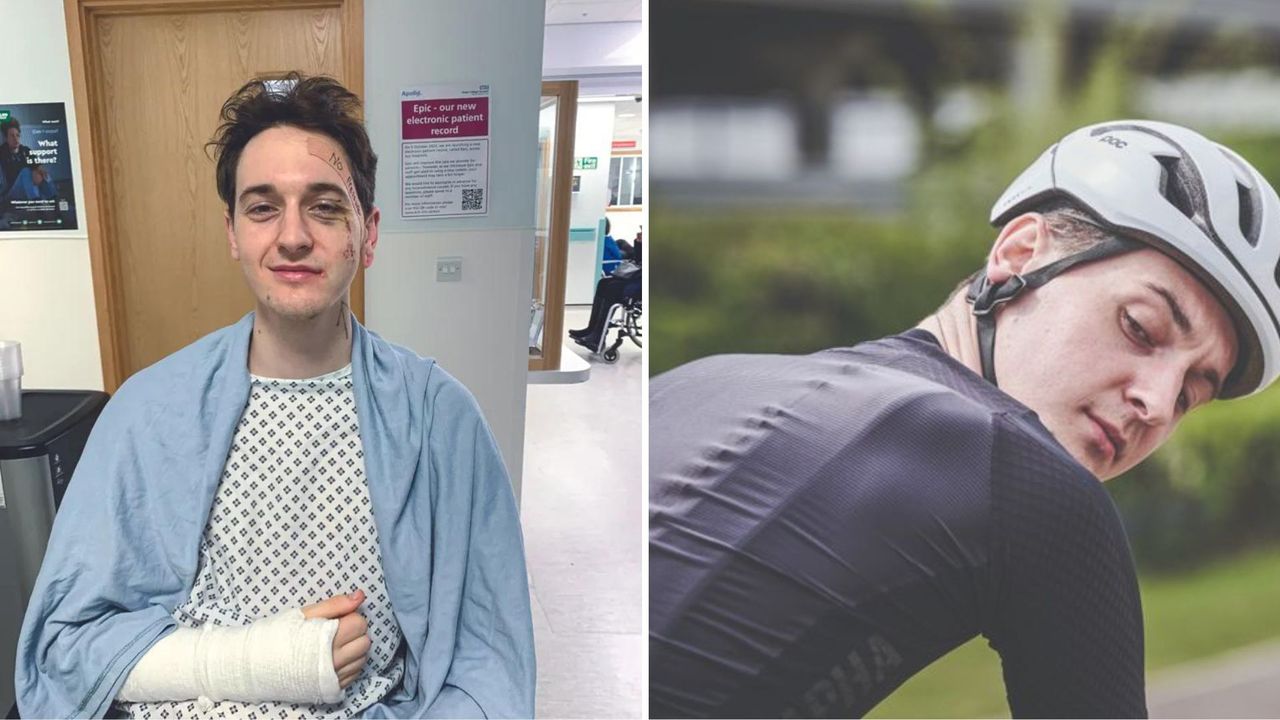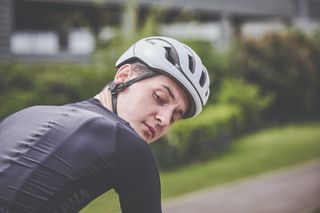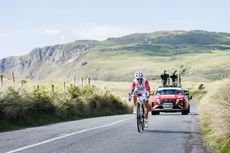7 things I learned from breaking my face
When a crash left CW’s Tom Davidson with a titanium plate in his cheek, his perspective on cycling started to change. Here’s what he took away from the saga


Earlier this year, I lived out one of my mum’s worst nightmares. It happened in an instant. I had cycled to the cinema to meet a friend, and while we were watching the film, the weather outside turned stormy. The wind gusts, I thought, would blow me home effortlessly. The ride lasted less than two minutes.
At the first corner – a sharp, wet left- hander – my front wheel slid violently, jackknifing my bike into the tarmac. I don’t remember the impact. All I remember is being scraped off the floor by three men with panicked expressions, who kept asking me if I was OK. Proudly, I shooed them away, but the throbbing in my face, the pain in my wrist, and the general dizziness I felt made it clear to me that I was not, in fact, OK.
The nurse in A&E helped me piece together the crash. My left cheek had hit the road, hard, and was now as flat as the tarmac it had bounced off. A CT scan confirmed three fractures in my face, plus a broken wrist, and I was booked in for emergency surgery 48 hours later. This would stop my “eye material” from “sagging” through the broken cheekbone, which sounded like a good idea. Today, a small titanium plate holds it all in place, and will do so for the rest of my life.
Crashes in cycling can be life-altering. They can drastically change our relationship with the bike, knock back our confidence, and leave us with lasting scars, a constant reminder of our own fragility. Mine, fortunately, aren’t visible. The surgeons did the whole procedure through the inside of my mouth, making the incision in my gum line. They never told me how many stitches they put in, but I counted seven or eight with my tongue. In the months that followed, as the stitches dissolved and I eased back into riding, my perspective on cycling started to shift. I felt an anxiety I had not experienced on my bike before. Here’s what I learned, and how I rebuilt my confidence.
1) You can't control how you crash

I had never had a serious crash before I broke my face. For years, I had ridden under the illusion that, should I ever go down, I would be able to style out the way I fell, manoeuvring my body to roll onto my shoulder and certainly avoid hitting my head. I saw Mark Cavendish do it at the Giro d’Italia last year; on wet roads in Salerno, the former world champion held onto his handlebars as he slid on his side across the finish line. He suffered no breaks, and went on to win on the final day in Rome.
I, however, am not Mark Cavendish.
Perhaps the scariest thing I learned from my crash is that you can hit the floor in a blink, falling before you can react. I never had a chance to touch my brakes or adjust my line through the corner. One second I was upright, the next I was in a heap on the floor.
Get The Leadout Newsletter
The latest race content, interviews, features, reviews and expert buying guides, direct to your inbox!
Now I’m acutely aware of how quickly my fortunes can turn, and I’m a more cautious rider because of it – something that has taken the sting out of my average speed but has got me all the way home every ride.
2) Concussion is no laughing matter
Though I was ultimately not diagnosed with a concussion, the doctors took the prospect very seriously – more seriously, in fact, than they took my broken bones. Immediately after the impact to my head, my memory blanked. I staggered, dazed, back to my friend’s house, where he asked me two questions. “Do you know what day it is?” I didn’t. “Do you know what we did this afternoon?” Again, I didn’t. I couldn’t recall the cinema.
Concussions generally take a few weeks to pass, but can have much longer-term effects. Taco van der Hoorn, who rides for Intermarché- Wanty and won a stage of the Giro d’Italia in 2021, suffered a “severe concussion” when he crashed at last year’s Tour of Flanders and still today, over a year on, is yet to return to racing.
If you bump your head in a crash, look out for symptoms such as confusion, dizziness and nausea, but also more subtle changes like forgetfulness and heightened irritability. These typically show up immediately, but can take up to three weeks to appear. If you’re in any doubt, go to hospital, or call 111.
3) After any impact, get a new helmet

Among the first questions the nurse asked me in the hospital was: “Were you wearing a helmet?” Had I said no, I’m sure I would have been met with an eye roll and a telling off. On this occasion I was able to say ‘yes’. “Good,” she said. “Throw that one away. You’ll need to buy a new one.” For all the broken bones in my body, that thought pained me the most. I had grown attached to my POC helmet, it only had a few small dents and scuffs, and, crucially, I didn’t want to shell out another £100-odd for a new one.
Here I have to admit that I had not read the advice that is often printed on a sticker inside a helmet, or at least in the accompanying literature. I checked in with Kask for more info. It said that it recommends replacing a helmet after any impact, “regardless of visible damage, as its ability to absorb future impacts may be compromised”.
The brand also said people should “regularly inspect their helmet for signs of deterioration such as cracks, detached parts, warping, flaking or changes in colour, and consider replacing it every three years from the original purchase date to ensure continued protection.” Now, I ride with a new helmet, the same model as before. I’ve kept the old one, too, which hangs in my bedroom as a keepsake, and a warning of what could have been.
4) I now wear a helmet on every ride
There has always been a prickly debate around wearing helmets. Some people say it’s futile, and only gives motorists confidence to drive recklessly around you. They’ll often cite the Netherlands, where people typically ride uncovered, their hair blowing in the wind.
Whether I’m out on my road bike or riding my single-speed runaround, as I was when I crashed, I always wear a helmet. For me, the case is simple. If there’s even the slightest risk of me falling and hitting my head – as there is every time I swing my leg over my bike – I want a helmet to protect me.
A positive thing that has come out of my crash is the reflection it has provoked in my cycling friends. One messaged me afterwards to say he was previously someone who “wears a helmet for ‘proper’ rides, but not for commuting or town riding”. My crash, however, “made him think”. The text made me smile.
5) Don't mess with the weather

Human foolishness is no match for Mother Nature. On the afternoon of my crash, storm Isha tore across London. I senselessly underestimated her. Gusts of up to 50mph were forecast in the capital. With them at my back, I figured I’d have an easy journey home, practically sailing back to my front door without a push on the pedals. How wrong I was.
Of course, rarely does a ride follow one straight road. With each slight bend, the wind’s impact on me changed, bringing with it a new turbulence. At the moment I turned left, my tailwind became a crosswind, which I’m sure scooped my front wheel from underneath me. I should have left my bike at my friend’s house and taken the train. We can’t control the weather, but we can control whether we ride in it.
6) Mental recovery takes longer than physical
The surgery only took an hour, and for a week or so afterwards, my left cheek ballooned with the swelling. I looked like I had lasted six rounds with Mike Tyson – provided the boxer was only allowed to deliver right hooks – with bruising to match as my skin coloured like turmeric- stained Tupperware. My wrist cast came off three weeks later and, in theory, I was ready to hit the road again. Except, I didn’t feel like it. I was experiencing a new feeling of vulnerability, a fear that I might cause myself damage again.
This is a normal phenomenon, psychologist Dr Marianne Trent told me. “Your body is physically ready, but your mind is going to perhaps need some additional kid gloves. That isn’t a negative thing, it’s just what we know about healing,” she said. “If we do things that are too much of a stretch for us, we’ll become hyper-aroused, which is when you might be anxious, you might have a panic attack, you might feel overwhelmed.”
To cope with this, the trick is to ease back into cycling, and be compassionate with yourself. Like me, Dr Trent had also crashed her bike and suffered a broken arm. Now, a year on, she had only recently been able to “mindfully” enjoy her first ride back. “There were big stretches of time where I wasn’t thinking at all about the accident, which is a clear indicator of healing,” she said. “I had this moment where I was like, ‘Ah, I think I’m better now. I think I’m recovered.’”
7) Cornering is king
I’ll be honest, in all my years riding, I’ve never really figured out how to corner smoothly on a bike. I’ve always proceeded through sweeping bends like a robot moving around a square. My brother likes to ridicule me for it – either I’ll lose three bike lengths to him ahead of me, or I’ll hear him behind me cackling at my line. To this day, he maintains that he learnt how to corner from playing first-person car video games as a kid. I, on the other hand, was more of a Guitar Hero guy.
Since my crash, I’ve become a keen student of the art of cornering. I’ve watched videos of the great masters and sought to replicate their technique. The general rule is to come into the corner wide, hit the apex, and come out of it wide as well. Leaning into the bend, you should lift up your inside knee and stretch out the other leg, pushing down on the outside pedal for balance. Don’t look down at the road in front of you. Instead, look out of the corner, towards the patch of road where you want to end up.
Do all of that, and you’ll look like a pro. Alternatively, you could just do what I do, which is slow down, roll through at a comfortable speed, and lap up my brother’s laughing behind me.

Thank you for reading 20 articles this month* Join now for unlimited access
Enjoy your first month for just £1 / $1 / €1
*Read 5 free articles per month without a subscription

Join now for unlimited access
Try first month for just £1 / $1 / €1

Tom joined Cycling Weekly as a news and features writer in the summer of 2022, having previously contributed as a freelancer. He is fluent in French and Spanish, and holds a master's degree in International Journalism. Since 2020, he has been the host of The TT Podcast, offering race analysis and rider interviews.
An enthusiastic cyclist himself, Tom likes it most when the road goes uphill, and actively seeks out double-figure gradients on his rides. His best result is 28th in a hill-climb competition, albeit out of 40 entrants.
-
 'There are no magic potions': how one rider is going better than ever in his seventh decade
'There are no magic potions': how one rider is going better than ever in his seventh decadeAt 65 years old, Joe Barr is thriving in a second career as an ultra racer
By James Shrubsall Published
-
 'I never thought in a million years I would beat Wout in a sprint' - Neilson Powless shocks with improbable Dwars door Vlaanderen win
'I never thought in a million years I would beat Wout in a sprint' - Neilson Powless shocks with improbable Dwars door Vlaanderen winVisma-Lease a Bike put on a show of force ahead of the Tour of Flanders on Sunday but came away without the victory in Waregem
By Tom Thewlis Published